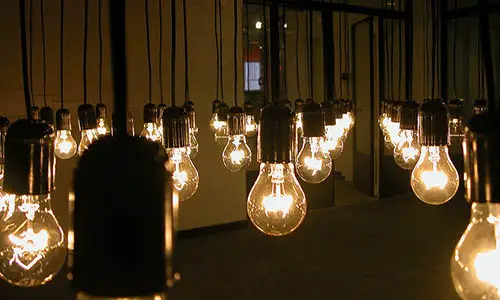The invention of the light bulb was instrumental in creating the modern lifestyle. We can work, read, and party late into the night. We can travel safely at night by road or by rail, through the air and over the waters all because the tiny little light bulb shows us the way.
The idea of making electric light was first put forward by British inventors. They demonstrated this with an arc lamp. In 1835 the first constant electric light was demonstrated.
FACT 1: The first patent for the incandescent lamp was actually awarded by the US government, to William Sawyer and Albon Man, who filed for the patent in January 1880. The incandescent lamps developed by them were too expensive to run as they lasted for a very short time.
FACT 2: Thomas Edison and his team worked on improving the filament that glowed in a vacuum when electricity was passed through it. They tried out platinum but finally settled a carbonized filament of uncoated cotton thread. This bulb glowed for 14.5 hours. Edison patented this invention in 1879.
FACT 3: By 1880 Edison was using bamboo filaments and his bulbs lasted 1,400 hours. Edison also developed the standard socket fitting for the light bulb. It was then known as Edison’s screw.
FACT 4: General Electric was formed by the merging of the companies owned by the rival patent holders, Edison and the Sawyer- Man pair. Joseph Swan had patented his light bulb in England. Eventually Edison teamed up with him as well to form Ediswan in England.
FACT 5: In 1904, European inventors developed the tungsten filament. These filaments glowed brighter and longer than the carbon filaments. In 1913, Irving Langmuir, figured that placing nitrogen in the bulb made it more efficient.
FACT 6: The German physician glassblower team of Julius Plucker and Heinrich Geissler discovered that light could be produced by removing almost all the air from a long glass tube and then passing electricity through it. These tubes are more efficient that the incandescent bulb, but they did not catch on until the early 20th century.
FACT 7: The oil crisis of the seventies led to the search for more efficient residential lighting. In 1976 Edward Hammer of General Electric, resolved the problem of linear fluorescent, by bending the tube. This was the beginning of the era of Compressed Fluorescent Lamps (CFL). The high cost of the machinery needed to mass produce CFL delayed the production of these bulbs.
FACT 8: A CFL lasts 10 times longer than an incandescent bulb. They hit the market in the mid 80’s.At first these bulbs were prohibitively expensive, but by the end of the decade the prices became more reasonable. CFL became a viable alternative for residential lighting.
FACT 9: The latest lighting technology is the LED (light-emitting diode) LEDs use a semi-conductor to convert electricity to light. LEDs are becoming more popular and in some countries governments are making an effort to keep the price of a LED within the reach of the common. Widespread use of LEDs will lead to a sizeable reduction in world energy consumption. LEDs have already gained popularity. They are used in traffic lights, torches and TVs.
FACT 10: Bulbs are sold by watts. A watt refers to the power the bulb uses. The efficiency of a bulb is measured by dividing the measure of emitted light (lumens) by the power drawn (watts). 100 % efficacy is 683 lm/W. By this measure the incandescent bulb (60 watt) has an efficacy of 15 lm/W, the CFL efficacy is 73 lm/W and the LED is 83 lm/W. We are still a long way off from 100% efficiency, but the researchers do not give up. They are always looking out for newer and better ways of saving energy on lighting.











Leave a Reply